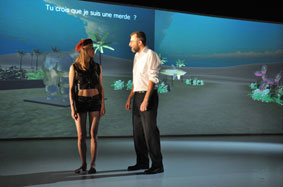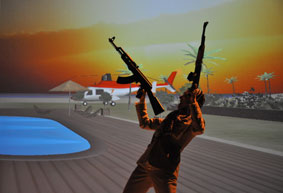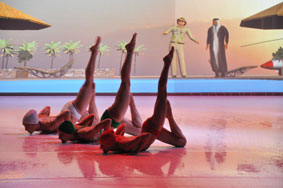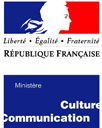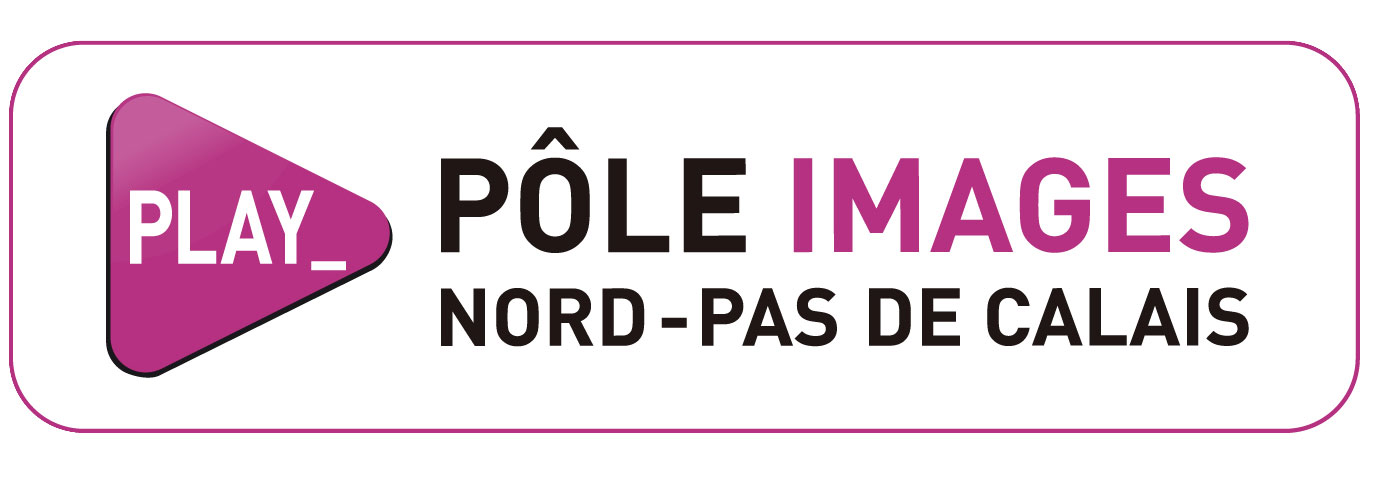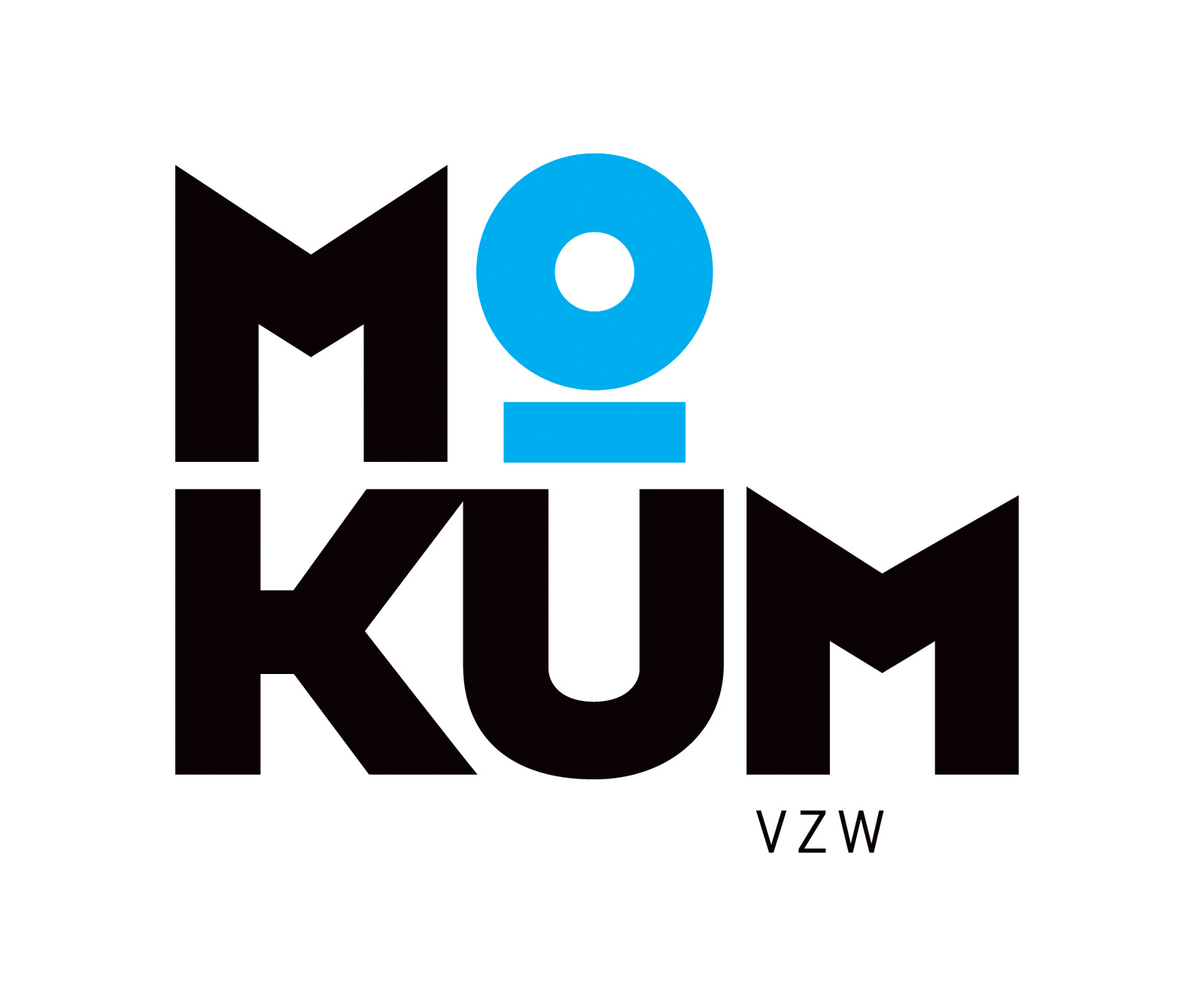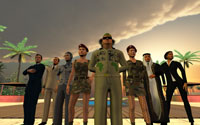
When considering techniques of disseminating ideas, we often make an analogy between the invention of book-printing in the fifteenth century and the emergence of the Internet toward the end of the twentieth century. The technical quantum leap is the feature shared by the Renaissance and our day and age. Similar analogies exist between other feats of human creativity and developments: in a certain sense, the computer-generated 3-D images lead us back to the invention of perspective by the Italian painters of the fifteenth century.
The birth of perspective in painting is not all disconnected from political considerations. As art historians have pointed out, the first stage in the construction of perspective is not the definition of the vanishing point but the definition of the frame, and painters give us a “framed” and “orderly” view of the world.
So, what can we say about the view of the world brought to us by an onslaught of digital images which we are confronted with every day? Nothing much has changed since the day and age of the Renaissance, it is still an enormously political thing. The powers-that-be have well understood that, and they have invested massively in the theatre of new technologies to stage some illusions of politics through the politics of illusion.
THEATRE, the latest SUPERAMAS project, is about the representation of a world structured by the politics of illusion. In this context, various extended reality techniques, such as 3-D images, avatars and mapping, are used.
These techniques will enable us to re-enact distinctive or anecdotal scenes from the international political arena. You will remember the French veto against war in Iraq in the UN General Assembly, and surely, you have not forgotten how Silvio Berlusconi kept Angela Merkel waiting for a long time at the NATO summit.
The stage will also become a site of improbable encounters. What would Marshall Tito have said if Silvio Berlusconi had kept him waiting? Real persons, fictitious persons and avatars will meet. Important decisions will be taken. A war might be in the offing. The stage might become a theatre of operations.
What SUPERAMAS is interested in here is the interaction between reality and fiction and the way it is at work in reports on current politics. The point is to rediscover the reality of comedy or drama behind the illusion of the political.
When the private life of public figures is in the focus of the politics of illusion, when the Crown Prince’s wedding or the First Lady’s pregnancy become societal issues, fiction has long relegated reality to the background. But then again, did not the Renaissance painters also give their madonnas the traits of the prostitutes who were their models?
SUPERAMAS will play true and false stories, navigate between reality and virtuality, always seeking to keep politics and the image of politics apart. Or mix it even more. The inter-actors will, however, be given an opportunity to see clearly: the toolbox will be opened before their very eyes. And we hope that their attention will be directed at the frame as much as at the vanishing point.
Dans les modes de diffusion de la pensée, le parallèle est souvent fait entre l'invention de l'imprimerie au 15ème siècle et la naissance de l'internet à la fin du 20ème. Le saut technique dresse un pont entre la Renaissance et aujourd'hui. Ce pont, d'autres créations et développements humains l'empruntent. Dans une certaine mesure, les images de synthèse en trois dimensions renvoient à l'invention de la perspective par les peintres italiens du Quattrocento.
La naissance de la perspective en peinture n'est pas étrangère à des considérations politiques. Les historiens de l'art l'ont montré, la première opération dans la construction d'une perspective n'est pas la détermination du point de fuite, mais celle du cadre. Et c'est une vision "cadrée" et "ordonnée" du monde que le peintre donne à voir.
Que dire, dès lors, de la vision du monde renvoyée par le flux d'images digitales auquel nous sommes confrontés tous les jours? Qu'il s'agit, comme à la Renaissance, d'un enjeu éminemment politique. Nos hommes de pouvoir l'ont bien compris, qui désormais investissent massivement le théâtre des nouvelles technologies pour mettre en scène une manière d'illusion du poltique, par la politique de l'illusion.
THEATRE, le nouveau projet de SUPERAMAS, s'attachera à représenter un monde structuré par la politique de l'illusion. A cette fin, il s'appuiera sur différentes techniques de réalité augmentée, telles que les images en trois dimensions, les "avatars" et le "mapping".
Ces techniques permettront de rejouer les scènes marquantes ou anecdotiques du théâtre politique international. On se souvient du veto français à la guerre irakienne à l'assemblée générale des nations unies. On n'oublie pas non plus Silvio Berlusconi faisant attendre de longues minutes Angela Merkel à l'occasion d'un sommet de l'OTAN.
Mais la scène deviendra également le lieu de rencontres improbables. Qu'aurait dit le Maréchal Tito si c'était lui que Silvio Berlusconi avait fait attendre? Des personnages réels, des personnages fictifs et des avatars se croiseront. On y prendra des décisions importantes. Il est même possible qu'une guerre s'y prépare. La scène deviendra alors le théâtre des opérations.
Ce qui intéresse ici SUPERAMAS, c'est l'articulation entre réalité et fiction à l'oeuvre dans les récits de la politique contemporaine. C'est de retrouver, derrière l'illusion du politique, la réalité de la comédie ou du drame.
Quand la vie privée des hommes publics devient la matière de la politique de l'illusion, quand le mariage du prince héritier ou la grossesse de la première dame deviennent des questions de société, la fiction depuis longtemps a pris le pas sur la réalité. Mais après tout, les peintres de la Renaissance donnaient déjà pour traits à leurs madonnes ceux des prostitués qu'ils faisaient poser.
En jouant du vrai et du faux, en naviguant entre le réel et le virtuel, SUPERAMAS s'emploiera à séparer la poltique de son image. Ou à les mélanger encore davantage. Le spectateur, en tout cas, aura l'occasion d'y voir clair: la boîte à outils sera ouverte sous ses yeux. Et son attention se portera, nous l'espérons, autant sur le cadre que sur la ligne de fuite.
Performed by Lucie Eidenbenz, Karen Lambæk, Lieve De Pourcq, Faris Endris Rahoma, Bahar Temiz and Superamas
Set design, sound and video: Superamas
Light design: Henri-Emmanuel Doublier
Motion capture concept and program: Pierre Gufflet
3D images design: Superamas in collaboration with TechnocITé Mons/Belgium, CCCP/France and Howest Kortrijk/Belgium, Kevin Marien
Real-time 3D engine: Pierre Gufflet, Superamas and CCCP/France
Computered 3D animation: CCCP/France, Howest Kortrijk/Belgium, Kevin Marien and Superamas
Technical Supervisor: Pierre Gufflet
Programming consultant: Yves Gufflet
Costumes: Sofie DurnezVoices: Susan Bentley, Dr. Siham Bouhlal, Bianca Brooke Martin, Nabil Rahoma, Prof. Jeffery Ruda, Justin Wadlow
Workshop: Prototoutyp
Stage Manager: Martin Schwab
Thanks to: Sandra Noeth, Bianca Brooke Martin, Ass. Prof. Olga Hazan, Luc Moreau
Produced by: Superamas
Co-produced by: Art Center Vooruit/Belgium, Maribor European Cultural Capital 2012/Slovenia, Künstlerhaus Mousonturm (in the context of Frankfurter Positionen 2013 - an initiative of BHF-BANK-Stiftung)/Germany, Maison de la Culture d’Amiens – Centre de création et de production/France, Szene Salzburg/Austria, Tanzquartier Wien/Austria, Stereolux, Nantes/France, CECN Manège Mons/Belgium, Impulstanz, Vienna/Austria, EN-KNAP Ljubljana/Slovenia.
In collaboration with: Buda Art Center, Kortrijk/Belgium, La Gaîté Lyrique Paris/France, TechnociTé Mons/Belgium, Howest Kortrijk/Belgium, Mokum/Belgium, l'Avant-Seine Théâtre de Colombes/France, Agglomération Maubeuge-Val de Sambre Gare Numérique de Jeumont/France, Internationales Figurentheaterfestival Erlangen/Germany.
Supported by: The City of Vienna/Austria, Ministry of Education Art and Culture/Austria, Direction Régionale des Affaires Culturelles d'Ile-de-France Ministère de la Culture et de la Communication/France, DICRéAM Centre National du cinéma et de l’image animée/France, l'Institut Français Ministère des Affaires étrangères et européennes in the context of the "Théâtre export" program/France, apap – advanced perfoming arts project/EU, Austrian Cultural Forum in Brussels, Pôle Images Nord Pas-de-Calais (avec le soutien du Conseil Régional Nord Pas-de-Calais, de Lille Métropole Communauté Urbaine et du Centre Régional de Ressources Audiovisuelles Nord Pas-de-Calais)/France, ONDA-Office national de diffusion artistique/France.
This work programme has been funded with support from the European Commission.
This publication (communication) reflects the views only of the author, and the Commission cannot be held responsible for any use which may be made of the information contained therein.
'THEATRE'
(DSL/Cable recommended)
